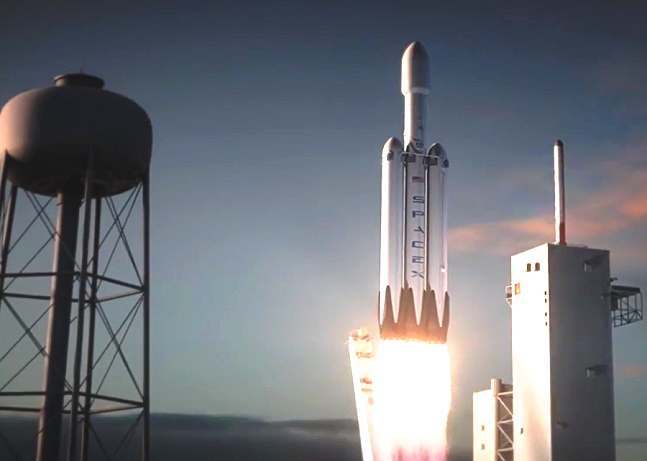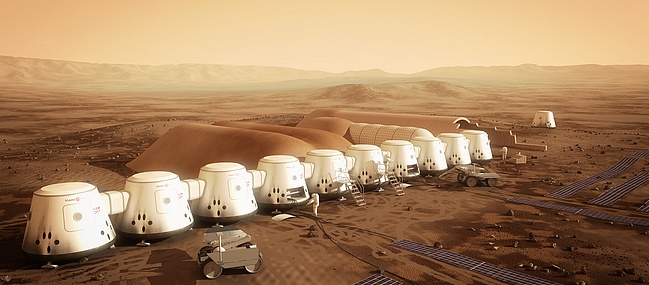Little noticed by many, but SpaceX has moved another step towards a Mars landing (from Nasa Spaceflight).
SpaceX has entered into an agreement with NASA for a Dragon mission to Mars, set to take place as early as 2018. Known as “Red Dragon”, the variant of the Dragon 2 spacecraft will be launched by the Falcon Heavy rocket, ahead of a soft landing on the surface of Mars. The mission is also part of an agreement with NASA to gain further data on Mars landings.
Getting mankind to Mars was the original purpose for the creation of SpaceX. Everything they have done, from building the Falcon rocket to creating the commercial launch service, has been to lay the technological and financial foundation for putting people on Mars, permanently. The next developmental step is to build and test the Falcon Heavy, a three booster version of the Falcon rocket.

Falcon Heavy will generate over 5 million pounds of thrust from 27 Merlin engines (9 engines x 3 cores) and have a payload of 119,000 lb to LEO and 30,000 lb to Trans-Mars Injection orbit (TMI) and 26,000 lb direct to Mars. Launch cost, minus payload, is expected to be around $90 million. According to Elon Musk, “Falcon Heavy will carry more payload to orbit or escape velocity than any vehicle in history, apart from the Saturn V moon rocket.” Falcon Heavy is expected to debut this year and make its maiden voyage from Vandenberg AFB. According to their agreement with the USAF, certification to carry national security payloads will occur after 3 successful flights and 2 successful consecutive flights.
Early payloads to Mars, including supplies and habitats, will be carried in the Dragon V2 spacecraft which will make propulsive landings on the surface. Dragon V2 is capable of carrying up to seven passengers, but has an interior volume comparable to an SUV, so it would not be suitable for a long duration journey. For that we will need something that is notionally called the Mars Colonial Transporter. It will carry sufficient supplies, living spaces, eating spaces, and everything required to support a crew of 5-10 people for the 3 month journey. The current SpaceX timeframe for putting its first ‘colonists’ on Mars is the mid 2020’s, so an MCT is not required for another 10 years. NASA, meanwhile, has begun planning for an upgraded Deep Space Network communications system in order to support increased human and machine activity at Mars as well as support increasingly capable and communications intensive space exploration missions. NASA itself is in the planning and development stages for its own humans on Mars missions sometime in the mid 2030’s and has undertaken the design of the Space Launch System (SLS) as a means to accomplish that and more.

For timeline comparison, consider this Illustrated History of the Saturn Program which even included a concept to return and recover the boosters on paraglider chutes:
1957 ~April
In April 1957 the scientific organization directed by Dr. Wernher von Braun began studies which led to Saturn, America’s first rocket developed for space investigation. The team at Redstone Arsenal, Alabama, hoped to design launch vehicles that could carry 20,000 to 40,000 pound payloads for orbital missions or 6,000 to 12,000 pound payloads for escape missions. High-thrust booster stages were essential.
December
In December 1957 the von Braun group, then working with the Army Ballistic Missile Agency (ABMA), proposed a program to the Department of Defense (DOD).1 At that time the United States was considering an integrated missile and space vehicle development program. Creation of a booster with 1,500,000 pounds of thrust was the aim of the proposed program.
1958 ~ August
On August 15, 1958, the Advanced Research Projects Agency (ARPA) formally initiated what was to become the Saturn project. The agency, a separately organized research and development arm of the Department of Defense, authorized ABMA to conduct a research and development program at Redstone Arsenal for a 1,500,000 pound thrust vehicle booster. A number of available rocket engines would be clustered. This design would be tested by a full-scale static firing by the end of 1959.2
Catch that? Concept to initial test firing of a 1,500,000 pound thrust vehicle booster in two years. That was early NASA. That’s when NASA was run by scientists and engineers and staffed by technicians who were veterans of WWII weapons and aircraft development and early jet aircraft development. They conceived an idea, refined and designed it, then went out about building and testing it right away. That approach is how we went from monoplanes to the SR-71 in twenty years. That is how we went from an idea for a heavy lift space vehicle in 1957 to men walking on the moon in 1969, twelve years later. SpaceX is run by the kind of people that used to run NASA. And the development work is paid for by the profits from the commercial side of their business.
Links:
The Saturn Propulsion System (video) – Interesting video from MSFC, 1962
Bonus link – Here’s a panning video of the CRS-8 first stage returning the droneship. Pan up to watch the booster descending to the ship. :-P
In 1955, I wrote a lengthy paper for my high school class (don;’t recall the subject) that was tilted, “The Principle of Rocket Propulsion.” I used the Arthur C Clarke book, “Interplanetary Flight” as a principle source.
From a review on Amazon.
To my mind this book is the single best moderately advanced reference on rockets, orbital mechanics, and space technology. Although it dates from about 1950, the physical principles it lays out have not changed. Rather, the predictions it made have largely been fulfilled. Because it is a very small book, it covers the essentials everyone with the necessary mathematical knowledge should know.
The book is at a level to be understood by one who has had a first-year college course in calculus and physics. Much of the mathematical detail is contained in an appendix, so that the remainder may be appreciated by a wider audience. I was able to read the whole in my sophomore year in high school, but I had to work pretty hard; in fact, I would say I learned calculus and elementary mechanics mostly from this book.
That’s about what my experience was. It would be fun to find my old paper and I now wonder what my teachers thought of it but that was what I was like at 16.
I was able to read the whole in my sophomore year in high school, but I had to work pretty hard; in fact, I would say I learned calculus and elementary mechanics mostly from this book.
You know, basic calculus and mechanics aren’t that hard. It’s all the variations and high level applications that start getting abstract and esoteric. My Calc II instructor was Swiss and commented that he’d been taught all of differential and integral calculus from a small, basic book. He was not impressed with the massive textbooks in use these days. He claimed they were so fat and unwieldy because, in order to sell books, a submitted problem was included from a textbook selection committee member from all colleges to which they wanted to sell it. Also, if you read an old science or math book, the concepts and illustrations are straightforward and and the explanations are in plain English, as opposed to the scientific-legalese in which they’re written today.
Falcon Heavy.
There’s a guy with the Wednesday night gig at Buddy Guy’s Legends who’s thinking, “shoot, why didn’t I think of that for my stage name?!?
Great stuff.
Two of the things that I wonder about the Falcon Heavy is whether the lift numbers include the overhead for stage return and whether the cost numbers include the savings for stage return. These are large variables.
“You know, basic calculus and mechanics aren’t that hard”
You should get a load of Visual Calculus by Mamikon Mnatsakanian. He solves integration with geometry and diagrams. It’s so intuitive he teaches it to grade schoolers and high schoolers, as long as they understand basic geometric concepts like the Pythagorean Theorem, congruence, and proportionality.
A little more in depth about it here
The method was conceived in 1959 by a young undergraduate student at Yerevan University in Armenia named Mamikon A. Mnatsakanian. Mamikon told me that when he showed his method to Soviet mathematicians they dismissed it out of hand and said “it can’t be right; you can’t solve calculus problems that easily. “Mamikon went on to get a Ph.D. in physics; he pursued a full time career as professor of astrophysics at the University of Yerevan, and became an international expert in radiative transfer theory. He also continued to develop his powerful geometric methods, and eventually published a paper in 1981 outlining these methods, but the paper seems to have escaped notice, perhaps because it appeared in Russian in an Armenian journal with limited circulation
I read their book. It’s a text book that gets pretty dry because they also include abstract and esoteric applications. I guess they wouldn’t be mathematicians if they didn’t. Here was a fun one where they took the anti-missile problem and applied some trigonometry to solve.
The basic concepts are still really cool, in a nerdy sort of way, finding the areas under curves with just elementary geometry.
I take some comfort in the fact that after all the leaps and bounds over all the rocky ground over the long centuries by all the great minds, everything we ever needed was laid out by some ancient Greek monks 2500 years ago.
Two of the things that I wonder about the Falcon Heavy is whether the lift numbers include the overhead for stage return and whether the cost numbers include the savings for stage return. These are large variables.
I believe the payload to orbit weights are independent of the additional fuel required for reentry and landing burn. The reason for the drone ship, as opposed to simply bringing all the stages back to land at Cape Canaveral, is that during missions where the payload is very heavy or that require a long push to the upper stage, there is insufficient fuel remaining to return all the way back to the Cape.
I have no answer for the financial question, but it’s a good one.